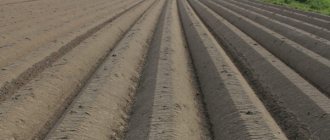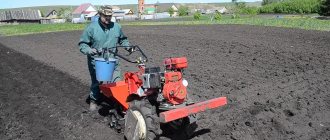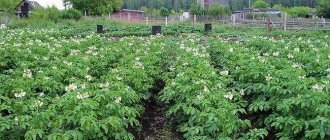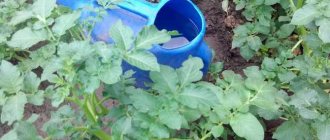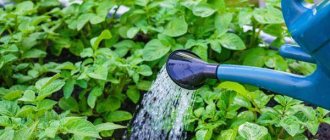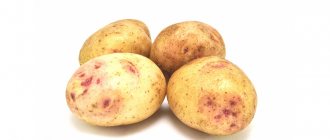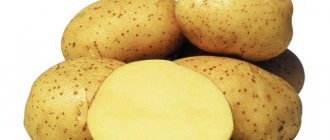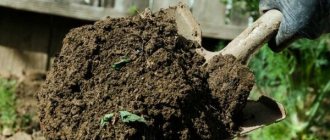Potatoes are one of the most popular vegetable crops, grown in all regions. To get a big harvest, you need not only to choose the right variety, but also to put a lot of effort into caring for the plants. Planting potatoes in boxes or boxes is one of the experimental ways of growing a crop, allowing you to minimize labor costs without compromising productivity.
In this article we will tell you how to grow potatoes in boxes, including those with air supply.
Features of the method of growing potatoes in boxes
The yield of the crop depends on the condition of the soil , the variety of potatoes and agrotechnical measures to care for it.
Tubers are formed at the ends of shoots-stolons extending from the stem . This means that their number directly depends on the length of the underground part of the stem, which can be increased by hilling.
The main advantages of the method of growing potatoes in boxes is the ability to significantly simplify the farmer’s task of caring for the crop and more efficiently use the area of the plot.
Description and essence of the method
The essence of the method is to plant potatoes not in the ground on the site, but in some container - for example, a box or box. As the plants grow, increase the height of the container and add soil mixture - this allows you to artificially increase the length of the roots and stimulate the formation of stolons.
If you follow all the recommendations and properly care for the plantings, the yield from one bush is about 5 kg.
Are all varieties suitable?
Potato varieties with a yield of at least 40 t/ha are suitable for planting in boxes and boxes .
The most suitable varieties:
- Shante;
- Slav;
- Nevsky;
- Sineglazka;
- Lugovskoy;
- Reliable;
- Youth;
- American;
- Anosta;
- Belarus;
- Mona;
- Resi;
- Lukyanovsky;
- Amazon;
- Marfena;
- Ramono;
- Santa.
Growing potatoes under straw
Growing for the lazy is the name given to planting potato tubers under straw.
Indeed, there is no need to dig up the soil, cover it with earth and remove weeds. And Colorado potato beetles do not like growing potatoes in straw. So there is no need to use chemicals. After 12 weeks, you should expect a harvest if you follow the following recommendations. In the fall, it is necessary to prepare the area for growing potatoes. It is not necessary to dig up the soil. You can treat the top soil layer with a Fokin flat cutter and then sow green manure. These green fertilizers, after mowing and incorporating into the soil, heal and enrich the soil.
In spring, the area is moistened and the potatoes are laid directly on the ground, maintaining a distance of 30 cm between tubers and 70 cm between rows. Then cover with straw or hay with a layer of 25 cm. When the plants rise to a height of 25 cm, hill up with straw. Under the straw layer, the soil remains moist, but in dry times you need to ensure that the soil does not dry out. Hilling up with straw must be done with the growth of potato bushes.
Advantages and disadvantages
The goal of all alternative methods of growing potatoes is to minimize labor costs in caring for the crop. Moreover, each method has not only positive, but also negative aspects.
According to experienced farmers, the following are the advantages of unconventional methods of growing potatoes :
- high yield from each bush;
- no need for hilling, weeding, or preparing beds;
- saving site area;
- the box planting method is suitable for regions with arid climates;
- the risk of attack on bushes by Colorado beetles is eliminated;
- ease of harvesting;
- the possibility of using the method in both open and closed conditions.
Flaws:
- the need to purchase or make boxes yourself;
- the possibility of slugs appearing in boxes or drawers;
- the need for specially prepared soil mixture;
- constant control of substrate humidity.
Traditional methods of planting potatoes
There are three common methods: smooth planting, ridge planting and trench planting. Moreover, this is precisely the case when an arbitrary choice does not give the best results, because each of the options is intended for very specific conditions and in others simply may not justify itself.
Only the basic requirements remain common: place plantings in the direction from south to north so that the plants are illuminated evenly and receive a sufficient amount of light; keep distances.
In addition, do not forget about fertilizing (I usually use ash and compost); It is useful to add onion peels to the holes or trenches, which protect the plantings from the Colorado potato beetle
7dach.ru
Conditions required for growing in boxes
Growing in boxes requires creating standard conditions for potatoes:
- air temperature +15…+25°C – at such indicators the above-ground part of the plant grows quickly and the growth of tubers is activated;
- humidity 70-80% - regular watering is necessary, especially after budding begins;
- intense lighting - this stimulates intensive photosynthesis of green mass, which has a positive effect on the yield and quality of tubers.
In the southern regions, potatoes are shaded - the combination of sunlight and high air temperatures can negatively affect plant growth.
Growing potatoes in the Urals
The unpredictable weather of the Ural region does not allow the cultivation of all varieties of potatoes. Therefore, it is important to use seed material suitable for cultivation in difficult weather conditions. For the Urals and Siberia, varieties of Siberian selection that are resistant to cold, drought and other weather conditions are suitable. Recommended varieties for the Urals included in the State Register:
- mid-early variety Nevsky;
- early ripening variety Udacha;
- mid-season variety Scarb;
- mid-season variety Naiad;
- early variety Spring White;
- early ripening variety Kamensky.
On the forums of summer residents of the Urals, the following varieties are very popular: Natasha, Gala, Sante, Red Scarlett, Rosara, Charodey.
Technology of growing in boxes
Planting potatoes in boxes or boxes is a rather unusual way of growing a crop. It does not require much effort and time, but it has some features.
Selection and preparation of containers
It is important that the container for planting potatoes is not toxic and has a size of at least 0.125 cubic meters.
To make your own box, you will need four wooden pegs approximately 0.5 m long and 20 wooden boards measuring 50x10 cm.
They are connected to each other to form a stable frame. Then thick plywood is attached to it, which will serve as the bottom.
Preparing tubers for planting
Tubers should be evenly colored, elastic, without damage or signs of rot . It is better to choose medium-sized planting material, weighing about 50-80 g. Small tubers will give low yields, while large ones will devote energy to the development of the above-ground part.
Before planting in the ground, the tubers are germinated - laid out in the light until small seedlings appear. Greened specimens are not discarded - during the growth process, the toxic solanine accumulated in them is naturally converted into safe substances.
Soil preparation
With this method, you cannot use ordinary soil from the site - it will not provide the plants with the necessary nutrients and, under such conditions, has extremely low air permeability.
A light and nutritious substrate based on peat is suitable - it is responsible for creating the most suitable microclimate and nutritional balance and retains moisture during the dry period. To reduce acidity and improve the quality of the soil mixture, peat is diluted by a quarter with river sand, and then 70-80 g of limestone flour is added for every 10 kg of mixture.
You can mix turf soil and humus or compost in equal proportions , then add a glass of wood ash to 10 kg of such soil.
Important! You cannot take soil from the place where potatoes were previously planted because of the likelihood that it contains toxins, pest larvae and infectious agents.
When to land
Considering that the growing season of potatoes is 3-4 months, and the optimal air temperature for the development of tubers and green parts is +15...+25°C, the optimal time for planting tubers is May.
Landing technology
The method of growing crops in boxes is in many ways similar to the traditional method , but still has some nuances.
Landing technology:
- Install boxes in the chosen location.
- Place a brick at each corner to create a small and well-ventilated foundation.
- Place paper on the bottom of the boxes, pour a mixture of humus and expanded clay on top (layer thickness - 5-10 cm).
- Place the sprouted tubers in the boxes, keeping a distance of 15-20 cm between them.
- Cover them with prepared soil mixture and mulch the ground with straw or moss.
When the sprouts reach a height of 10 cm, they are covered with soil again and do this until budding begins.
Growing potatoes from sprouts
Potato sprouts are good seed material for growing potatoes.
If you want to grow your favorite potato variety, but there aren’t enough tubers, then this method is perfect. A month before the intended planting, potatoes are selected for sprouting eyes.
On the day of planting, the sprouted tubers are cut into small pieces about the size of a teaspoon. Each fragment should have 2-3 well-ripened eyes.
Potato pieces are placed in prepared furrows according to a 15x30 pattern with a planting depth of 10-12 cm. It is good to plant peas, beans or beans between the planting material. These crops improve soil fertility by enriching them with nitrogen, provide shade and repel pests.
When the air temperature rises above 20° C, potato seedlings should be mulched with mowed dry grass, sawdust, and straw. Next, you need to adhere to standard care for potato plantings.
Further care
Potatoes in boxes do not require labor-intensive care and need standard agrotechnical measures: watering, fertilizing, protection from diseases and pests.
Top dressing
Fertilizing scheme:
- two weeks after planting the tubers - a solution of mullein or chicken manure with the addition of urea;
- at the beginning of active growth of green mass and the formation of tubers - potassium-phosphorus fertilizers;
- 20 days before harvest - a mixture of manure and superphosphate.
Fertilizers are applied at the root or sprayed on the green part of the plants.
Watering mode
Potatoes are watered once every 7-10 days at the rate of 5-10 liters of water for each container . It is important that the entire substrate down to the lower layers is moist. At the same time, it should not be allowed to become waterlogged - this leads to the development of putrefactive processes.
Watering is carried out in the morning or evening to prevent excessive evaporation of moisture.
Protection from diseases and pests
To prevent the development of diseases and pest attacks, plants are treated 2-3 times per season with insecticidal and fungicidal preparations - for example, Aktara, Confidor or Prestige.
Important! Treatment begins no earlier than a month after planting.
Mineral fertilizers for growing potatoes
For a good potato harvest, regular application of mineral fertilizers is necessary.
The process of feeding young tubers is especially important if the soil is poor and the beds have been cultivated for a long time. Such soil does not contain the optimal set of nutrients for successful potato growing. What fertilizers to use
- In the fall, it is necessary to add a full range of mineral fertilizers to the soil. For these purposes, ammophos, nitroammophos, and nitrophos are used. Fertilizers are diluted according to the attached instructions.
- When planting potatoes, fertilizers that have worked well include: superphosphate, nitrophoska, kemira, and ash.
- Bone meal added before flowering will improve the root system, enhance flowering and even improve the taste of the tubers.
Feeding potatoes using the Mittlider method
American farmer Jacob Mittlider not only developed the famous beds for growing vegetables, but also proposed the use of a special mineral feed for potato tubers.
So, when preparing the beds for planting, you should dig small grooves 5 cm deep along their long sides and sprinkle them with lime fertilizer made from calcium and boron. The mixture is used in an amount of 100 g per 1 linear meter. If the soil is loamy or acidified, then the amount of fertilizer applied should be increased to 130 g per linear meter.
During the growing season, it is necessary to feed the potatoes at least three times:
- the first fertilizing is carried out immediately after the emergence of potato shoots;
- the second feeding is needed when the potato bushes grow to 15-20 cm;
- During flowering, potatoes need a third feeding.
Fertilizers are applied into a 5 cm trench dug between the ridges. Now that potato plants are growing above ground, Mittlider suggests a mineral mixture consisting of nitrogen, boron, potassium, magnesium, molybdenum and phosphorus. Fertilizers are placed in the groove at the rate of 6 40-50 g per 1 linear meter and sprinkled with earth. Fertilizing is combined with watering the potatoes.
Foliar feeding
Potatoes respond well to foliar feeding, especially after rain. To do this, potato bushes are sprayed directly over the leaves with a solution of 3 tablespoons of superphosphate dissolved in 10 liters of water.
For cold regions with a long and rainy spring, foliar feeding with complete mineral fertilizer is important. 200 g of superphosphate, 20 g of urea, 20 g of potassium chloride and 1 g of copper sulfate are mixed in 5 liters of water. The solution is kept for 4 hours, then the potato bushes are treated at the beginning of budding and during flowering. This quantity is calculated per 100 sq.m.
What difficulties can you encounter when growing in boxes?
When cultivating potatoes in boxes, the following problems may arise::
- rotting of root crops in case of excessive watering - this can be avoided by removing the bottom of the box or making holes in it;
- drying out of plants due to loss of moisture in the absence of mulching;
- poor growth and development of culture if the boxes are placed incorrectly - for example, in the shade.
How to care for potatoes
The main concern is watering. Since the box is on the ground and the volume of soil in it is small, the soil dries out very quickly. You can’t count on rain with such a planting - practically no water gets into the box, even with heavy rain it all remains on the tops.
So watering is required twice or thrice a week, it all depends on the weather. I poured out at least 30-40 liters at a time, but it’s still impossible to fill the potatoes in the box - the excess moisture will go away.
The potato tops grew very large and could not support themselves. Therefore, I had to tie it up so that it would stand upright.
The method of planting potatoes in boxes saves gardeners from hilling. But other elements of potato care are not canceled. Watering in boxes is difficult due to the confined space, so it is necessary to install (dig) four metal pipes with radial holes into the first layer of soil, which is about 40-50 cm thick.
These holes are made at different heights to supply water to the lower layers of the soil. In addition to watering, they can also be used to feed plants. It is necessary to apply fertilizers and carry out preventive measures to protect against late blight, Colorado potato beetles and other pests in the same way as with the classical scheme for growing potatoes.
To understand whether this technology works, you need to try it yourself. This spring you can try the method in action. To do this, you just need to find some boards. And in the fall you can get a rich harvest from one potato.
In addition to watering, I used mulching, but I couldn’t put a lot of mulch in the box - the area was too small.
The harvest was harvested on the first of October. The plan was to remove the boxes one by one and see what was inside. But we were only able to remove the first box. We couldn’t remove the second one, so we just turned it over. We weighed the potatoes - it turned out to be a little more than 12 kg. Even if we subtract the weight of the bucket, the yield from the bush was 11.5 kg.
Someone asked what the maximum number of tubers I had was. I’ve never counted before, but here I got 72 tubers, of which 12 tubers are smaller than a chicken egg. There were no very small tubers.
vsaduidoma.com rusfermer.net
When and how to harvest
Under optimal climatic conditions, potatoes in boxes ripen 3-4 months after planting the tubers - in central Russia this is most often mid-September. Dried tops indicate the readiness of the crop for harvesting.
Reference. Under favorable weather conditions, the harvest can remain in boxes until the beginning of October.
To harvest, simply disassemble the box and empty the contents . An additional advantage of this method of growing potatoes is that all the tubers remain clean, undamaged by a shovel or fork.
High-yielding potato cultivation, on which the yield depends
Full-fledged and high-quality potatoes can be obtained if the following conditions are met:
- healthy planting material of good potato varieties should be planted;
- Until the soil warms up to 10-12°C, it is not recommended to plant potatoes;
- sprouted tubers will come to the soil surface faster;
- the potato bush is formed powerful and spreading if the air temperature does not exceed 23°C;
- loose and fertile soil will ensure good potato growth;
- Watering and timely feeding with fertilizers provide a full-fledged potato harvest.
Conditions for landing
Choosing the right potato variety is the key to successful work.
The following varieties are suitable for planting in a box:
It is recommended to select planting material well. Potatoes for planting should weigh from 50 g to 80 g.
On a note. If you plant low-quality, small potatoes, the harvest will be small. Very large tubers contribute to the active development of the above-ground part. Green tops will take away the main nutrition, and the crop will grow average
To grow a vegetable, you can leave the variety you like that was used previously.
It is recommended to germinate the tubers before planting. To do this, they are laid out in a bright place until small seedlings appear.
What you will need for disembarkation
You need to either buy or make wooden boxes yourself. It is important to install pallets or boxes without bottoms correctly. Pegs are driven into the ground, boards are attached to them or pallets are placed on them. The box can be built from boards and pine blocks.
The site for planting should be chosen in the sun, on an elevated, flat surface.
In the place where the boards are attached, small holes are drilled for screws. Such boards can be used for several years.
Soil for planting
To grow potatoes in boxes, the gardener should prepare special soil. The basis of the soil is a peat mixture. It has a loose structure, absorbs and retains moisture well. In the sun, peat can warm up completely. Plants growing in peat mixture are less susceptible to attacks by pests and diseases.
Soil for planting
You can enrich the peat mixture by adding a layer of sand. It should be ¼ of the soil. Limestone or chalk is mixed into peat, at the rate of 70-75 g per 10 kg of soil.
On a note. If there is no peat mixture, you can replace it with soil from the site, which must first be mixed with compost and ash.
Ash is used in any method of planting potatoes to prevent diseases and protect tubers from pests. It is not advisable to use manure as fertilizer before planting potatoes in boxes. Insect larvae multiply in it, which can harm the plant.
The soil in which potatoes grew cannot be reused. Often pathogens that cause tuber diseases remain in the ground. This soil can be used to grow other garden crops, and new soil is prepared for potatoes.
It is not recommended to place boxes for growing potatoes on the shady side of the plot - the bushes are affected by late blight.
Substrate preparation
You need to start preparing the soil in the fall, but it is important to consider that land on which nightshade crops previously grew, including tobacco, eggplant, tomatoes, peppers, etc., is not suitable.
This is a necessary measure to protect the crop from late blight, as well as other diseases and their pathogens. In addition, you cannot take the land where the mole cricket lives.
Suitable soil must be weeded, steamed or treated with chemicals so that later weeds and pests do not penetrate into the bags, which will be difficult to remove in confined spaces.
Potatoes in bags need more nutrients than tubers growing in open ground. So, you should prepare one of the following soil mixtures:
Garden soil and compost (humus). They are taken in equal parts. Fallen leaves, manure, sawdust or dust can be used as compost, and the soil can be black soil, yellow sand, or a small amount of clay to retain moisture. Land and fertilizers. It is necessary to mix humus soil with potassium and phosphorus fertilizers. To maintain optimal proportions, add 0.25 cups of complex fertilizer per bag (about 4 buckets of soil)
It is important to note that if pure humus is used, which was taken from a manure or compost heap, then there is no need to use minerals
It is worth considering that when forming a soil mixture, special attention should be paid to its looseness and breathability. To do this, before putting it into bags, the soil must be sifted, and solid fractions, roots of weeds and pests such as wireworms and mole crickets must be removed.
Thanks to these simple steps you can get beautiful, smooth root vegetables.
Planting seedlings in the ground and subsequent care
In the third ten days of May, provided the weather is consistently warm, the seedlings can be transplanted to a permanent place. To do this, it is advisable to choose an area where the predecessors were legumes or pumpkin crops, as well as cabbage and cucumbers. Dig a hole up to 10 cm in the soil and add about 300 g of compost or humus into it.
It is important to moisten the hole after fertilizing, using at least half a liter of water.
If the plants were planted in plastic cups, carefully cut them and transfer the earthen ball into the hole. The replanting process is much easier in the case of peat pots. They are simply placed in a hole, after which they are sprinkled with fresh substrate.
Important! Potato tubers should not be planted in unheated, damp soil. In such an environment, there is a high risk of infection with fungal and bacterial infections. Until the bushes get stronger, they need to be carefully looked after
We are talking about regular watering, loosening and weeding of the soil. To prevent dryness and waterlogging of the earthen coma, take into account weather conditions. For example, in hot weather the plant needs to be watered once every 2 days. There will be two hillings in one season
Until the bushes get stronger, they need to be carefully looked after. We are talking about regular watering, loosening and weeding of the soil. To prevent dryness and waterlogging of the earthen coma, take into account weather conditions. For example, in hot weather the plant needs to be watered once every 2 days. There will be two hillings in one season.
How to grow
From an economic point of view, it is more profitable to make the boxes yourself. Also take note of the rules for preparing seed potatoes, planting them and caring for the plant.
How to make a box
For work you will need pine beams (4 pieces up to 2 m high) and boards; you can use wooden pallets. It should be taken into account that 50 cm of the box will be buried in the ground, and 1.5 m will remain above the ground, that is, the boxes should not have a bottom.
For the walls you need boards measuring 15x2x150 cm. About 10 boards are taken on each side, the exact number is calculated depending on the material used. The purpose of such walls is to hold the ground.
It is recommended to drive stakes on a flat or elevated surface. The area should have been well lit.
Tuber preparation
The future harvest depends on the correct preparation of planting material. It is necessary to choose high-quality potatoes without damage.
If necessary, large potatoes can be cut in half. Each part must have at least 2 sprouts. But it is best to plant potatoes whole. In this case, it should be medium in size.
Landing
It is recommended to place boxes on the south side of the house. The bottom is covered with spunbond and filled halfway with compost. Several medium-sized tubers should be planted in one container. Next, the potatoes are sprinkled with soil or compost. The last stage is mulching with straw, dry leaves or moss.
For growing, it is recommended to use only prepared soil: free of weeds and rich in nutrients. Mulch helps retain moisture and nutrients.
How to care for a vegetable
Growing in boxes without a bottom is no different from caring for a crop in a regular garden bed. When the tops grow to 12 cm, you can add a new layer of soil. The sprouts fall asleep at ⅓ of their height.
Adding layers of earth is carried out to the very top of the box, this lasts until mid-July. Then the bushes grow without bedding.
